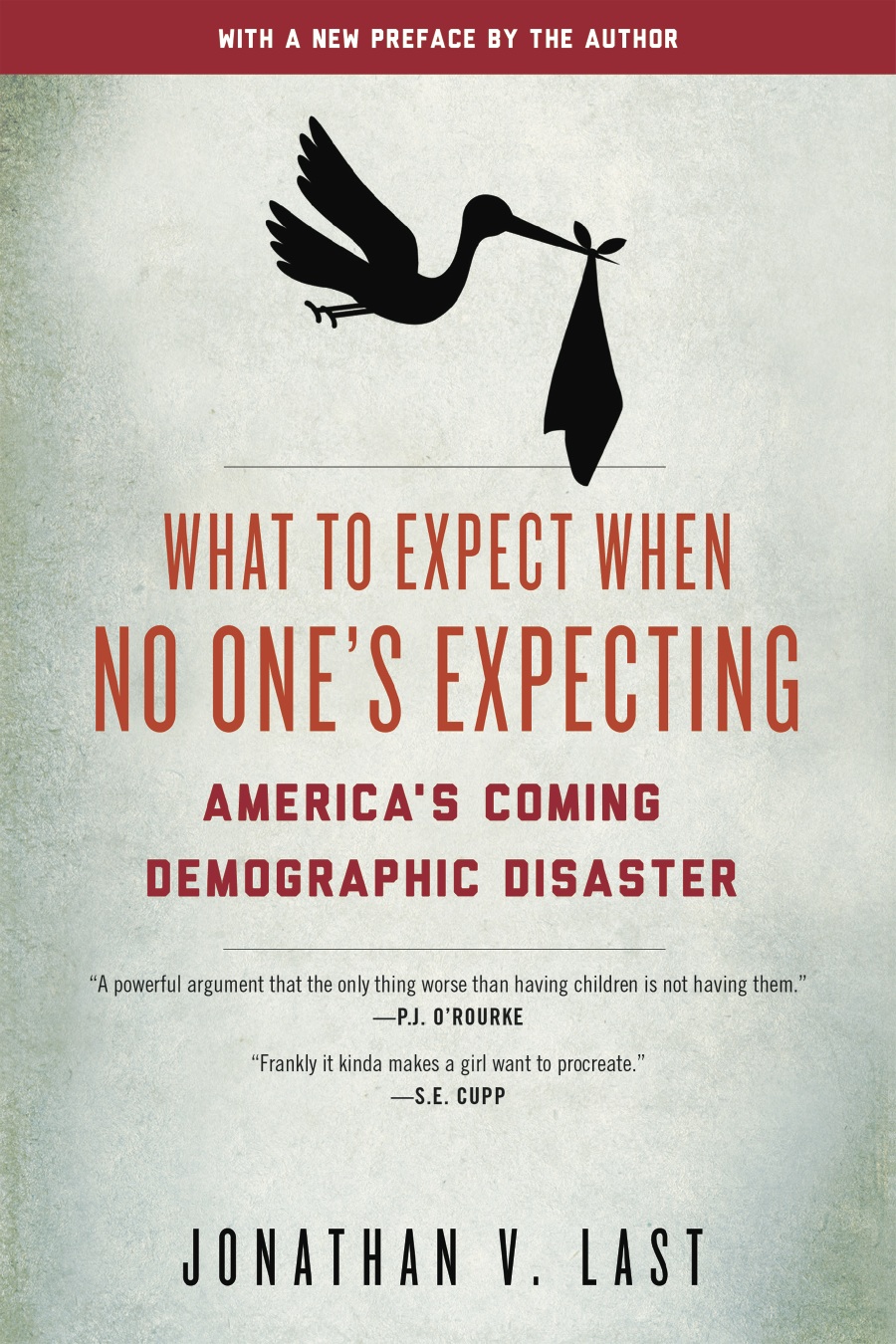February 26th, 2013
Two more reviews today. The first is by Scott Yenor at Public Discourse. It’s really high-minded–much more so, I’m afraid, than the book is. He groks What to Expect so completely that it gets a little creepy at times:
Last synthesizes scholarly research with an engaging blend of statistics, anecdotes, and judicious observations. His is very much a book for contemporary readers, as he sympathizes with many of the advances that have, in turn, fostered population decline. I imagine Last at a coffeehouse in a toney urban neighborhood, looking out at his mini-van and wondering if he and his wife should have more children. He appreciates the pull of post-family culture, but he is still a human being in the old sense of seeing himself as part of an intergenerational compact.
It’s like he’s staring into my soul.
Then there’s a piece by Isabel Sawill from Brookings. I’m a big fan of the Brookings Institution in general and Sawhill in particular. Her work is smart and incisive. In particular, her research and writing over the years on the links between marriage and prosperity have been incredibly valuable. (See here and here and here.)
She’s one of my favorite progressive sociologists because she’s always been fearless about following the data and making crucial arguments–like, for instance, about the importance of marriage as a means to ending poverty–that were unwelcome by certain other segments of the left. She’s great.
So I was a little disappointed to see her taking a shot at What to Expect by arguing (I’ll paraphrase here) that we don’t need any more babies; all we need are more immigrants. Sawhill references the book, but quotes a line from my Wall Street Journal article. And she seems to be intuiting my stance on immigration not through either of those, but rather through Ruy Teixeira’s strange review in The New Republic.
It’s all so odd that I’d ask Sawhill whether she’s read the book closely.
The reasons I’d ask are:
(1) She seems to misunderstand my thoughts on immigration entirely.
(2) She says that American fertility won’t come back even if we follow “the kind of family-friendly policies” that I support. But (a) What to Expect is incredibly modest in even putting forward policy ideas for discussion, let alone endorsing any; and (b) The book makes pretty clear that I suspect that policy changes are likely to be effective mostly at the margins.
(3) When Sawhill writes that “expecting women to rededicate themselves to producing children is not in the cards” she seems to be ignoring a large chunk of the book which deals with ideal fertility rates, the argument of which is that to the extent we do look at policy solutions, we shouldn’t be hectoring women (and men) into “rededicating themselves to producing children” so much as figuring out how to help them achieve their fertility aspirations. Again, Sawhill is arguing with a point I never make. In fact, a point which is nearly the opposite of the book’s thesis.
Sigh. It would be nice if some of my friends on the left would read What to Expect When No One’s Expecting with some care. If they did, I suspect they’d find that our points of disagreement are probably quite narrow.
As a substantive matter, I’d push back gently against Sawhill’s larger argument on two points.
The first is that it strikes me that she’s being slightly cavalier about the effect of immigration on the lower-end of the wage scale. It’s one thing to argue that this effect is a regrettable cost for a greater good. Her dismissal of immigration as only harming “some of our least-skilled workers” is particularly surprising since she has spent so much of her career examining the causes of, and solutions for, systemic poverty. One of the lessons I’ve taken from Sawhill’s work over the years is that we’re supposed to worry most about the mobility and welfare of our least-skilled workers so that they don’t fall into the underclass. This dismissal seems out of character for her.
Second, I go to great lengths in the book to detail how vital immigration has been, and continues to be, to our demographic profile. I also discuss its limits. For instance, while immigration provides a great deal of demographic relief it is, as an objective technical matter, inferior to baby-making in that it does not provide the same rejuvenation effect on a society’s age profile. For a deeper exploration of the math on this, I’d point readers to Carl Schmertmann’s work. I would have thought that Sawhill might at least acknowledge some of these limitations in the course of making her broader argument.
-
Just working my way through your population book through the night. You should send a copy to the Pope, either past or new. He might be surprised by your numbers and how the teaching of the Catholic Church ends up being the most responsible in this area.
-
This rebuttal shows impressive restraint. The Sawhill article was shockingly bad. It reads like the kind of argument that comes 100% from politics rather than data. For example, breezily glossing over any and all differentiations between those 7 billion interchangable parts — potential citizens — such as education, skills, economic sector, etc.
I’m also unclear on what the long term plan is for replace-the-populace enthusiasts. Will all rich country’s self-unselecting populations just be replaced every few generations as long as their are enough benighted breeding grounds to supply the bodies?







Galley Wife February 27, 2013 at 7:09 pm
Maybe you wrote in invisible ink. Hey, be happy to be misread: better be that than some of the other things I have become. : ) If I could tag my own posts, this would be “remember when we were young and unencumbered and saw aimee mann live at the 9:30 club and…”